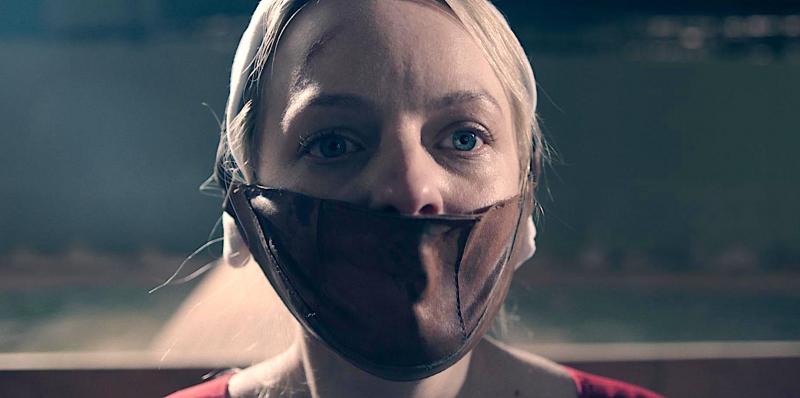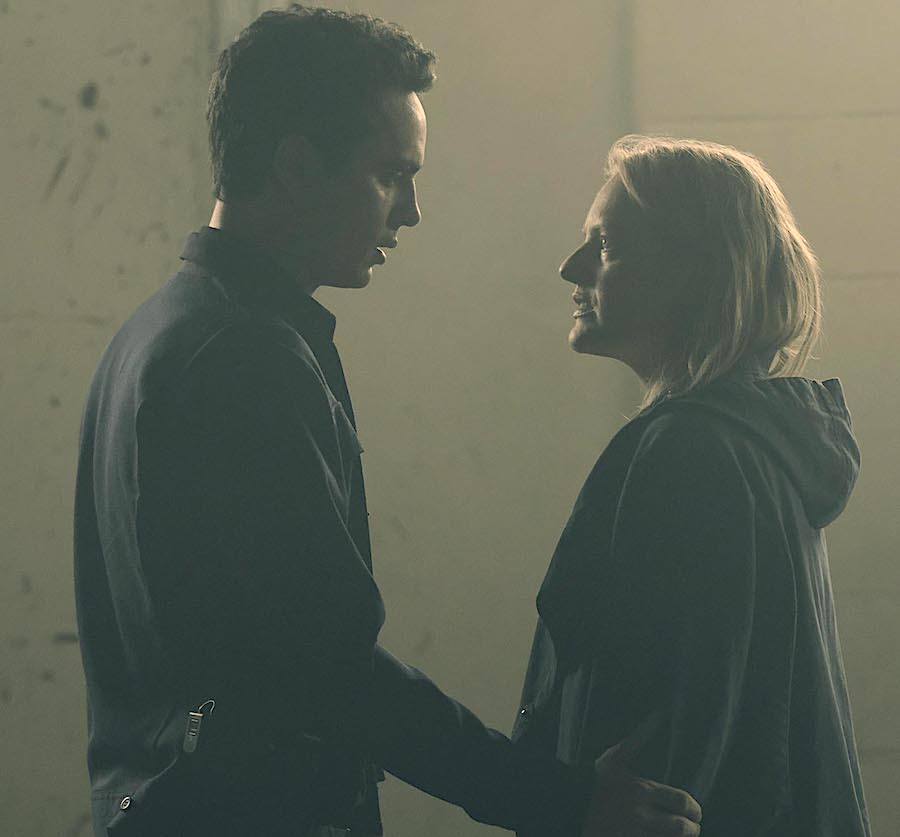The Handmaid's Tale, Series 2, Channel 4 review - it's not getting any better for Offred | reviews, news & interviews
The Handmaid's Tale, Series 2, Channel 4 review - it's not getting any better for Offred
The Handmaid's Tale, Series 2, Channel 4 review - it's not getting any better for Offred
Further horrific adventures in the Republic of Gilead

Not the least startling element of Bishop Michael Curry’s house-rockin’ sermon at the royal nuptials was his quotation from the old spiritual “There is a balm in Gilead”. Evidently the Bishop was not referring to the endlessly looping nightmare that is The Handmaid’s Tale, where “Gilead” means not balm, but torture, terror, misery and misogyny.
The first series used up Margaret Atwood’s source novel, so series two relies on showrunner Bruce Miller and his team of writers to take the narrative onwards, while also filling in background information about how the Gilead Republic came into being, with rights of women and minorities being steadily whittled away and the former US government annihilated in devastating terror attacks. It’s safe to say that Handmaid 2 is going to be even darker than its predecessor, and we haven’t even got to the gruesome radioactive wastelands known as The Colonies yet, the Gilead Republic’s very own concentration camps where “Unwomen” are sent to die a painful, lingering death. That comes next week, in an episode you may find difficult to sit through.
Ofwyatt drank drain cleaner in an attempt to induce a miscarriage
The story picked up precisely where we left off last time, with Elisabeth Moss’s Offred being carted away in the back of a van to an unknown destination. She didn’t know if she was going to be executed or rescued by the Resistance. In fact she and dozens of fellow handmaids were taken to the derelict shell of Fenway Park, home to the Boston Red Sox in happier days, and (now wearing sinister leather gags) made to stand on high platforms where their heads were placed in nooses.
The iconography of the scene – theatrically orchestrated mass murder in a ruined symbol of the decadent former times, shot in muted but carefully coordinated colours – revealed the hand of a diabolical designer. Kate Bush’s “This Woman’s Work” wailed eerily on the soundtrack, perhaps a reminder (though hardly a necessary one) that career opportunities for female singer-songwriters are negligible in Gilead. Then one of the Gilead stormtroopers gave the execution order… but it was just a bluff. The petrified women were being punished by the gloating Aunt Lydia (Ann Dowd, who one imagines may be becoming an “unwoman” in her own social circle after taking this role) for their unspeakable crime of not stoning to death Ofdaniel at the end of series one.
 However, it’s revealed that Offred is pregnant, so for the time being will be being spared the casual horrors doled out to her fellow-maids. When she declines to eat a meal, Lydia takes her to see Ofwyatt, who drank drain cleaner in an attempt to induce a miscarriage, and is now chained up in a prison room. Later, in another warning to bolshy Offred, another handmaid is attached to a kitchen gas ring while it incinerates her hand.
However, it’s revealed that Offred is pregnant, so for the time being will be being spared the casual horrors doled out to her fellow-maids. When she declines to eat a meal, Lydia takes her to see Ofwyatt, who drank drain cleaner in an attempt to induce a miscarriage, and is now chained up in a prison room. Later, in another warning to bolshy Offred, another handmaid is attached to a kitchen gas ring while it incinerates her hand.
It’s all enough to keep you awake at night, though sometimes the show’s litany of sadism begins to look dangerously like torture-porn. There’s a kind of paradox, too, in the way that a series which has been championed as a feminist call to arms is almost entirely taken up with depicting horrific crimes against women.
There was a glimmer of hope when Offred was indeed whisked away into hiding by the Resistance and the enigmatic Nick (Max Minghella, pictured above with Moss), and cathartically burned her handmaid’s uniform and reclaimed her real name, June Osbourne. You think her freedom is going to last, though?
The future of Arts Journalism
You can stop theartsdesk.com closing!
We urgently need financing to survive. Our fundraising drive has thus far raised £49,000 but we need to reach £100,000 or we will be forced to close. Please contribute here: https://gofund.me/c3f6033d
And if you can forward this information to anyone who might assist, we’d be grateful.

Subscribe to theartsdesk.com
Thank you for continuing to read our work on theartsdesk.com. For unlimited access to every article in its entirety, including our archive of more than 15,000 pieces, we're asking for £5 per month or £40 per year. We feel it's a very good deal, and hope you do too.
To take a subscription now simply click here.
And if you're looking for that extra gift for a friend or family member, why not treat them to a theartsdesk.com gift subscription?
more TV
 Murder Before Evensong, Acorn TV review - death comes to the picturesque village of Champton
The Rev Richard Coles's sleuthing cleric hits the screen
Murder Before Evensong, Acorn TV review - death comes to the picturesque village of Champton
The Rev Richard Coles's sleuthing cleric hits the screen
 Black Rabbit, Netflix review - grime and punishment in New York City
Jude Law and Jason Bateman tread the thin line between love and hate
Black Rabbit, Netflix review - grime and punishment in New York City
Jude Law and Jason Bateman tread the thin line between love and hate
 The Hack, ITV review - plodding anatomy of twin UK scandals
Jack Thorne's skill can't disguise the bagginess of his double-headed material
The Hack, ITV review - plodding anatomy of twin UK scandals
Jack Thorne's skill can't disguise the bagginess of his double-headed material
 Slow Horses, Series 5, Apple TV+ review - terror, trauma and impeccable comic timing
Jackson Lamb's band of MI5 misfits continues to fascinate and amuse
Slow Horses, Series 5, Apple TV+ review - terror, trauma and impeccable comic timing
Jackson Lamb's band of MI5 misfits continues to fascinate and amuse
 Coldwater, ITV1 review - horror and black comedy in the Highlands
Superb cast lights up David Ireland's cunning thriller
Coldwater, ITV1 review - horror and black comedy in the Highlands
Superb cast lights up David Ireland's cunning thriller
 Blu-ray: The Sweeney - Series One
Influential and entertaining 1970s police drama, handsomely restored
Blu-ray: The Sweeney - Series One
Influential and entertaining 1970s police drama, handsomely restored
 I Fought the Law, ITVX review - how an 800-year-old law was challenged and changed
Sheridan Smith's raw performance dominates ITV's new docudrama about injustice
I Fought the Law, ITVX review - how an 800-year-old law was challenged and changed
Sheridan Smith's raw performance dominates ITV's new docudrama about injustice
 The Paper, Sky Max review - a spinoff of the US Office worth waiting 20 years for
Perfectly judged recycling of the original's key elements, with a star turn at its heart
The Paper, Sky Max review - a spinoff of the US Office worth waiting 20 years for
Perfectly judged recycling of the original's key elements, with a star turn at its heart
 The Guest, BBC One review - be careful what you wish for
A terrific Eve Myles stars in addictive Welsh mystery
The Guest, BBC One review - be careful what you wish for
A terrific Eve Myles stars in addictive Welsh mystery
 theartsdesk Q&A: Suranne Jones on 'Hostage', power pants and politics
The star and producer talks about taking on the role of Prime Minister, wearing high heels and living in the public eye
theartsdesk Q&A: Suranne Jones on 'Hostage', power pants and politics
The star and producer talks about taking on the role of Prime Minister, wearing high heels and living in the public eye
 King & Conqueror, BBC One review - not many kicks in 1066
Turgid medieval drama leaves viewers in the dark
King & Conqueror, BBC One review - not many kicks in 1066
Turgid medieval drama leaves viewers in the dark
 Hostage, Netflix review - entente not-too-cordiale
Suranne Jones and Julie Delpy cross swords in confused political drama
Hostage, Netflix review - entente not-too-cordiale
Suranne Jones and Julie Delpy cross swords in confused political drama

Add comment